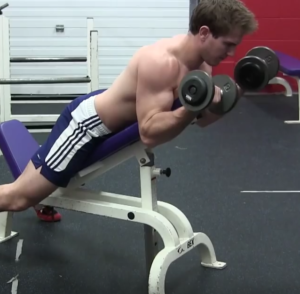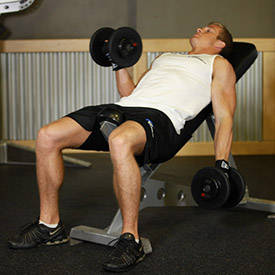Why Is Knowing Anatomy Important?
Criminal Minds is my wife’s favorite show (therefore, it is my favorite show…or at least my most watched show).
In each episode they spend most of the time figuring out why the killer does what he does. Why does he kill them this way? Why did he choose that victim? The more they know about him, the more power they have over him, like identifying who is, or where he’ll strike next.
The same approach is helpful in working out. If you know about a muscle’s makeup and function, you’ll have more power over it. You’ll be able to make it stronger and grow, by exercising it properly.
Biceps Brachii
The biceps’ scientific name is biceps brachii. It has two heads, two functions, and spans two joints. Knowing the anatomy and physiology of your biceps is the cornerstone of creating a great workout plan that will get you the results you want. It’ll help you answer, is this a good exercise for my biceps? Should I do this exercise, or this one? What’s the difference between this way and that way?
The Two Functions
The biceps’ two functions are elbow flexion and forearm supination.
Elbow flexion is when you bring your hand closer to your shoulder. When you think of working out your biceps, you likely think of doing your standard dumbbell biceps curls, which is working out elbow flexion.
Forearm supination is when you twist your wrists outwards. In other words, it’s the act of going from a palms down to a palms up position.
When your elbow is at 90 degrees and you supinate, you can see your biceps flexing.

Let’s go back to the dumbbell curl. A standard dumbbell curl starts with your palms facing forwards, and they remain in that position for the whole exercise. A supinated dumbbell curl starts with your palms facing your body, and as you curl, you supinate, too. This exercise works flexion and supination.
The Two Heads
 The two heads of your biceps are the short head and the long head. They lie next to each other, with the short head being on the side closer to your body, and the long head being on the side farther away from your body. When you think of a biceps “peak” that’s mostly the long head of the biceps.
The two heads of your biceps are the short head and the long head. They lie next to each other, with the short head being on the side closer to your body, and the long head being on the side farther away from your body. When you think of a biceps “peak” that’s mostly the long head of the biceps.
You can’t isolate working one head and not the other, however, you can do some exercises that emphasize one over the other, which we’ll cover in the next section.
The Two Joints
 Your biceps start above your shoulder, and insert below your elbow, so they actually span two joints. This means that the location of your elbow affects how stretched or flexed your biceps are, which is important.
Your biceps start above your shoulder, and insert below your elbow, so they actually span two joints. This means that the location of your elbow affects how stretched or flexed your biceps are, which is important.
You want to work out your muscles in both the more stretched and the more flexed positions. The long head of your biceps is actually stretched more when your elbows are behind your body, which causes it to take on more of the workload (remember the long head gives you the peak you want).
In the more flexed position, more muscle fibers can fire. Both of those benefits will help you get bigger and stronger.

For instance, when you’re doing a spider curl, your elbows are out in front of your body. In the finished position of a spider curl, your biceps are more flexed than in the finished position of other curls.

On the other hand, if you’re doing an incline curl, your elbows are back behind your body. In the starting position of the incline curl your biceps are more stretched than the starting position of other curls.
Working out your biceps in these different positions is key to getting bigger and stronger biceps.
Best Supporting Actor: The Brachialis
In the gun show, the biceps are the stars and the brachialis is the supporting cast.

The brachialis lies below the biceps and pushes them up, allowing them to get all the attention. Since the two muscles are stacked on top of each other, the bigger the brachialis, the thicker your arm, and the more pronounced your biceps will be.
Unlike the biceps, the brachialis has one function: elbow flexion. It is actually a stronger elbow flexor than the biceps.
While doing all your biceps curls you’ll hit your brachialis, but if you want to give it some special lovin, throw in some hammer curls. Since there is no forearm supination in hammer curls, your biceps have less power in this movement, which makes your brachialis work a little bit harder.
Conclusion
To recap: your biceps have two functions, two heads and span two joints. Below your biceps lies the brachialis.
Supinated dumbbell curls will work both functions of your biceps, preacher or spider curls will work your biceps in the flexed position, and incline curls will work your biceps in the stretched position. To hit your brachialis and get a thicker arm and more pronounced biceps, throw in some hammer curls.
Using this knowledge, you can confidently pick the best exercises to reach your goals.
For a broader overview of how biceps anatomy fits into how to build bigger biceps, check out our Ultimate Guide to Building Bigger Biceps.